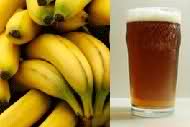 Banana beer is a weak alcoholic beverage that is popular throughout Africa. It is made by fermenting bananas with a cereal flour (often sorghum flour). It is sweet and slightly hazy with a shelf life of several days under correct storage conditions. The processing method and ratio of ingredients used varies widely from country to country and with personal taste. In Kenya, banana beer, made from sorghum or millet flour, is known as urwaga. In Uganda, banana beer is known as lubisi. This technical brief describes one traditional method, and suggests ways in which the hygiene and safety of the product can be improved.
Banana beer is a weak alcoholic beverage that is popular throughout Africa. It is made by fermenting bananas with a cereal flour (often sorghum flour). It is sweet and slightly hazy with a shelf life of several days under correct storage conditions. The processing method and ratio of ingredients used varies widely from country to country and with personal taste. In Kenya, banana beer, made from sorghum or millet flour, is known as urwaga. In Uganda, banana beer is known as lubisi. This technical brief describes one traditional method, and suggests ways in which the hygiene and safety of the product can be improved.
Ingredients
Ripe bananas
Boiled water
Roast ground cereal
Raw material preparation
Only ripe bananas (Musa species) should be used to make the beer as these have a high sugar content, which is necessary for the fermentation. Over-ripe bananas should not be used as they may spoil the flavour of the beer. Unripe bananas should be left to ripen before they can be used. Ripening can be speeded up by warming the fruit. During the rainy season, unripe bananas can be left to ripen laid on a hurdle over the fire where the cooking is done. During the dry season bananas can be ripened by making a pit in the ground, covering the sides of the pit with green banana leaves, packing the bananas into the pit and then covering them with banana leaves and earth. On one side of the pit a little ditch should be dug for a fire so that warmth and smoke can enter the pit. This takes about six days.
The bananas should then be peeled. If the peels cannot be removed by hand the bananas are not sufficiently ripe and should be left for longer.
Processing
The first step is the preparation of the banana juice. It is important to obtain a high yield of clear banana juice that is not spoiled by browning or contaminated by spoilage micro-organisms. Ensure that the vessels used for pulping the banana and extracting the juice are clean before use.
Knead the bananas until they are soft and pulpy. Use a stiff grass to help knead and squash the banana pulp and to extract the juice. The pulp residue will remain in the grass. Pour off the extracted juice into a large clean bucket or similar container. This banana juice is non-alcoholic and can be diluted and drunk at this stage if desired.
Add clean boiled water to the extracted juice (one volume of water for three volumes of banana juice). It is necessary to dilute the banana juice so that the concentration of soluble solids is low enough for the yeast to ferment the juice. Grind the cereal (sorghum or millet) and lightly roast it over an open fire. Add the roast cereal (1 part cereal to 12 parts juice) to the diluted banana juice. Cover the bucket with a clean lid and leave in a warm place to ferment for 18 to 24 hours. The ground cereal improves the colour and flavour of the beer.
After fermentation the beer is filtered through a sterilized cotton cloth.
Packaging and storage
Packaging is usually only required to keep the product for its relatively short shelf life. Clean glass or plastic bottles should be used. The product should be kept in a cool place away from direct sunlight.
Hygiene and quality assurance
Banana beer is made from raw material that does not undergo any heating or cooking at any stage of the process. The banana pulp is an excellent substrate for microbial growth – both of the desirable yeasts and the non-desirable spoilage bacteria. The fermentation is brought about by natural yeasts that are present on the banana. Heating or boiling the raw material would kill these natural yeasts and spoil the traditional flavour of the beer. It is essential that strict attention is paid to cleanliness of the equipment and processing area and to personal hygiene to avoid contamination of the beer with other bacteria that may form acid rather than alcohol.
It is best to sterilize the equipment prior to use with boiling water. Chlorinated water can be used to clean the equipment, but this is not recommended as the chlorine can affect the fermentation.
Flow diagram
Raw materials Ripe bananas
|
Peel Peel by hand
|
Remove residue Use grass to knead or squeeze out the juice. The residue will remain
|
Mix with water The water: banana juice ratio should be 1:3
|
Mix with cereal flour Mix with ground and roasted cereals to local taste. For sorghum the ratio should be 1:12
|
Ferment In plastic container. Leave to ferment for 18 to 24 hours.
|
Filter Through cotton cloth
|
Pack In one-liter plastic bottles with cork stoppers or equivalent
|
Store
Improved method for banana beer
The process can be made more hygienic and the quality of product improved by following a typical method for making a fermented beverage. This involves the preparation of a wort (which is a boiled starter substrate), addition of a commercial source of yeast, fermentation under controlled conditions (time and temperature) followed by pasteurization to stop the fermentation. The product made by this improved method will have a different taste and appearance to the ‘live’ beer produced by the traditional method. The improved beer can be bottled and stored and will be consistent from one batch to the next.
Equipment required
Beer making does not require any specialist equipment. All equipment used should be of food-grade and should be thoroughly cleaned before use.
Knives
Filter bags (cotton cloth)
Fermentation vessel (plastic bucket)
This document was produced by Dr. S Azam Ali for Practical Action in March 2008. Dr. S Azam-Ali is a consultant in food processing and nutrition with over 15 years experience of working with small-scale processors in developing countries.
This article is licensed under the GNU Free Documentation License. It uses material from the Practical Action’s Technical Brief Banana Beer. [“Banana Beer“]
Do you like this money making business ideas? then please consider subscribing to our RSS feed and have new business ideas sent directly to your inbox. (Once you entered your e-mail address, you need to login to your e-mail account and click the link to confirm your subscription).




what grass can be used for this?